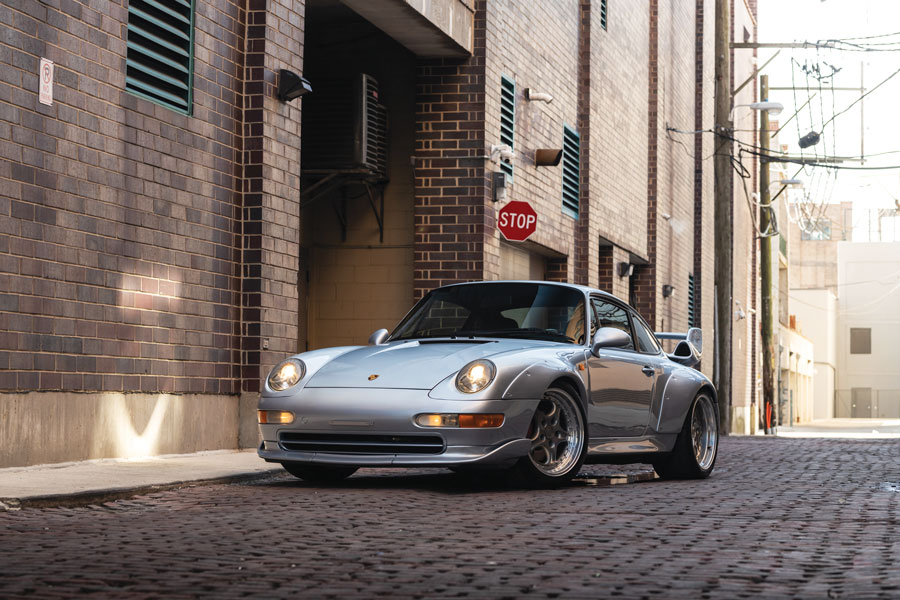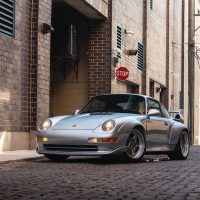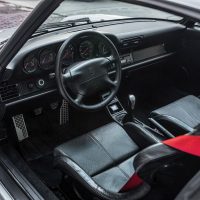SCM Analysis
Detailing
| Vehicle: | 1996 Porsche 911 GT2 |
| Years Produced: | 1996–98 model years |
| Number Produced: | 194 (161 Strasses, 33 Club Sports) |
| Original List Price: | $195,000 |
| SCM Valuation: | $874,000 |
| Tune Up Cost: | $4,000 |
| Chassis Number Location: | Aluminum tag on passenger’s side inner fender, stamping on cross member below gas tank, tag on base of windshield — driver’s side |
| Engine Number Location: | Passenger’s side fan support upright — under lots of gear; bring a very small mirror and a flashlight |
| Club Info: | Porsche Club of America |
| Website: | http://www.pca.org |
| Alternatives: | 1994–98 McLaren F1, 1995–97 Ferrari F50, 1996 Porsche GT1 |
| Investment Grade: | A |
This car, Lot 435, sold for $891,000, including buyer’s premium, at RM Sotheby’s Online Only Palm Beach auction on March 28, 2020.
The 1996–98 Porsche Type 993 GT2 is an immensely desirable factory hot rod. It is the highest-horsepower, best-performing — and yet totally roadable — epitome of air-cooled 911s. It belongs in every serious Porsche collection.
From relatively unknown to iconic
GT2s were never sold in North America. Like most 964-993-996 Porsche hot rods, the GT2 was a homologation car built as a base for a derivative race car.
Because homologation required low production numbers, Porsche sold out in “rest-of-world” markets that excluded North America. There was no need to submit cars to U.S. crash testing or pay for DoT/EPA gear.
Most GT2s stayed in Europe.
Some went to other markets, notably Japan. The Japanese were financially flush and enthusiastic about Porsche’s special models. A decade later, Japan became a prime source, in part because the Japanese order spec included left-hand drive, air conditioning, radio and power windows. The Japanese preferred their exotic cars in left-hand drive — easier to be recognized as special — and that led to power windows for paying tolls through the passenger’s side of the car.
From $400k to $2.5m in four years
North American Porschephiles appreciated 1973 Carrera RSs. They were front bookends of many collections of high-performance 911s.
After the 21-car run of SC/RSs in 1984, the next widely available RS came in 1992, with the 964 Carrera RS 3.6-liter, followed in 1993 by the much hairier RS 3.8-liter, then in 1995–96 by the 993 RS and the GT2.
Collectors looking to build a run of such “supercars” had 2,282 Type 964 RSs in three variants to choose from, just 55 RS 3.8s, 1,014 Type 993 RSs, but just 194 GT2s. In 2011–12 GT2s regularly sold for about $400,000. By 2015, prices were over $1,000,000. A very original Riviera Blue GT2 sold in 2016 for $2,476,320. The car was one of just six in that color.
What did you get?
For what you paid in any era, you got a lot of car with a GT2.
With a $500 million development budget, the 993 introduced an all-new body style, a new induction system and a new rear suspension. The fared-in headlights, integrated bumpers and muscular side sculpting made the look. The dual-wishbone, aluminum-subframe rear suspension replaced the traditional trailing arms and made the handling. New in 1995 for the RS and in 1996 for the C2/C4, the VarioRam telescoping-tubes induction made the torque.
As part of the 993 development program, Porsche redesigned the 993 street Turbo for 4-wheel drive, utilizing the 3.6-liter engine pushed up to 408 horsepower with smaller and faster-spooling twin turbochargers. It pulled to 60 mph in under four seconds and topped out at 183 mph. That car, especially in Turbo S guise, is also a collector favorite.
The GT2 is born
To go racing in the BPR series, Porsche had to ditch AWD. To build the homologation street car, Jürgen Barth’s race department took a Turbo body, adapted it to 2-wheel drive, tweaked the engine and suspension, added bulbous bolt-on flares — like the 934 — and the GT2 was born.
Handling was managed with bigger brakes, adjustable sway bars and nine-inch-by-18-inch front, 11-inch-by-18-inch rear Speedline three-piece Supercup wheels.
The G64/51 gearbox was 6-speed with a variable 40%–65% lockup.
To make the car light, hood and doors were aluminum, thin glass was deployed, wheel centers were magnesium and the interior was lightened. There was no undercoating or sound insulation, and no DoT/EPA equipment. Air conditioning, power windows and airbags were optional. The GT2 weighed in just under 3,000 pounds — 440 pounds lighter than a street Turbo.
The Type M64/61 engine had remapped Motronic controls and increased boost to 13 psi. It developed 398 foot-pounds of torque and a very conservative 430 horsepower. Power was tweaked to 450 horsepower for the 21 GT2s built in 1998 — but those cars reverted to steel (vs. aluminum) doors and to thick glass (#1026 5 mm vs. #1057 3.5 mm) — and many considered it a questionable trade-off.
Only 194 ever built in two variants
Porsche sold 194 GT2s over three years — 161 “Strasses” and 33 Club Sports — cars further stripped for track days with race seats, harnesses, fire bottles and a roll cage. Porsche also built 79 GT2 race cars in a separate series with many small but impactful modifications. In the U.S., Jochen Rohr and Champion Racing used those GT2s to win or place 2nd at big races at Daytona, Sebring and other tracks in 1995–98. The cars also ran in the European BPR series.
What has happened to values?
The best GT2s seldom get to the public market, while a lot of troubled cars do go to auction, which is often seen as a “clean” way to get out of a problem car. See my profile of chassis 062 in SCM’s December 2017 issue.
That said, GT2s do not often fare well at auction. Starting in 2015, of the last 12 GT2s at auction, only five broke $1,000,000, with four more in the $900,000-plus range. We know that some of those GT2s were good examples. Relative to private sales, all seemed to have sold light.
On to our GT2 at auction in Palm Beach
Which gets us to our subject car, chassis 164. It was in Japan from 1995 until 2016.
It was what we call a “parallel import” car — bought new for German delivery (German delivery code “C00”) by a Japanese dealer, ArtSport in Osaka. The car was immediately imported and sold in Japan with 50 km (31 miles) on the odometer. The first owner kept it for 13 years and sold it in 2009 with 20,000 km (12,427 miles). The second owner was an elderly doctor who sold the car in early 2016 for export to the U.S. At that time, it had 29,500 km (18,330 miles). It was very original, with minor repainting. It had all the typical Japanese electronic add-ons: a worthless radio, toll flacker, radar detector — all of which came out with no harm.
There was no evidence of any body damage. No body panel had ever been off the car. All the numbers were correct, as were the trim, bolts, fasteners, hoses and welds. It had continuous service stickers.
Oh my. It was a steal!
The car had, in effect, one owner in the U.S., a well-known dealer and his financial backer, who can be presumed to have taken good care of the car.
They were asking $1,500,000 for the car at my last viewing in February. It went to auction showing 30,113 km — about 18,700 miles. The car was in standard Japanese spec with option codes 573 (a/c), 651 (power windows), 652 (dual airbags), 567 (upper green tint on windshield), and 451 (reduced radio prep with lightweight door speakers).
It was a very usable car.
It hammered at $810,000 for a final price of $891,000 including the 10% buyer’s premium. Perhaps COVID-19-induced ennui or the difficulty of buying a high-dollar car via an online auction contributed to the weak result.
Or, we may be missing something big. But the car was flat-out stolen. Congratulations to the buyer. Presumably the rest of us were having a nap or a family picnic in the backyard. Pity us. ♦



